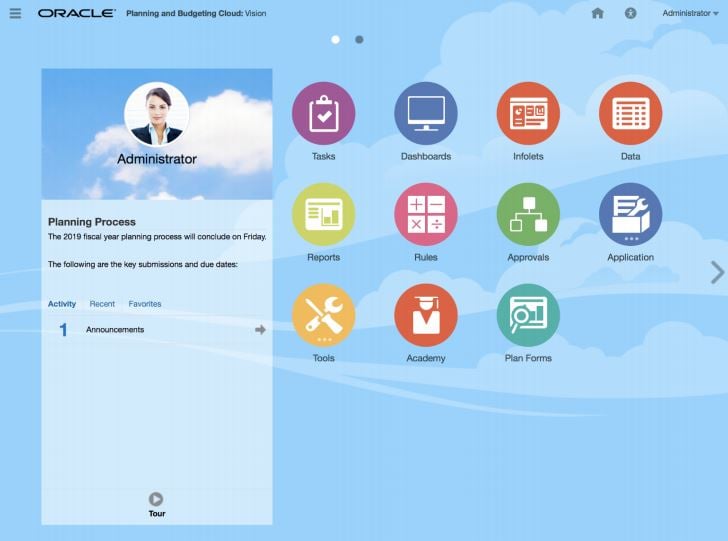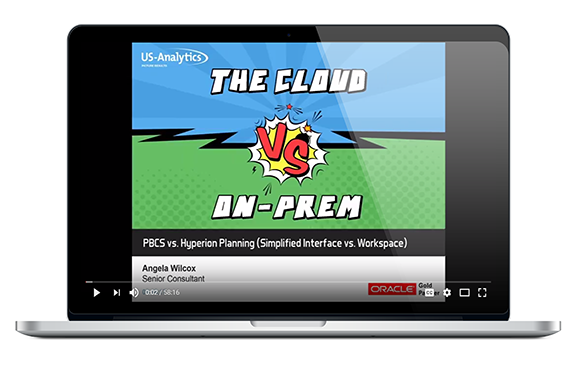The July updates for Planning in the Oracle EPM Cloud have arrived. This is the first set up updates since Oracle changed the structure of the EPM Cloud and pricing plans.
The monthly update for Planning in the Oracle EPM Cloud will occur on Friday, July 19 during your normal daily maintenance window.
Planning Updates
New Oracle EPM Cloud Features Tool
Oracle has released an EPM Cloud Features tool. Use this tool to quickly find features released each month
for your EPM Cloud business process. Click a link to learn more about each feature in the What’s New
document and the EPM Cloud user assistance.
REST API Updates
When using REST APIs to import security records, you can now download the error message file. Additionally, you can now use the Sort Members REST API with Free Form applications.
Changes to Provisioning Terminology
With a view to standardizing the terminology around assigning roles to users at the identity domain,
application, and artifact levels, EPM Cloud has changed such labels in the user interface to "Assign". Because of this change, the labels of Provision Roles tab and Provisioning Reports tab in Access Control have been renamed to Assign Roles and Role Assignment Report respectively. Similar changes have been made to the access control screens displayed in business processes and EPM Connections.
Export Expanded Reports to Excel
Now you can include expanded rows and columns when you export a Financial Report to Microsoft Excel.
- From the Home page, click Reports, and then click the report you want to see.
- Select an export option for the report, and expand your choice of rows and columns.
- Click the Export to Excel toggle on the top left of the page.
Maintenance Notification in the Simplified User Interface
Starting with this update, a notification indicating the imminent start of the daily maintenance process will be displayed to all active users. This new notification in the Simplified User Interface will be displayed to all active users 15 minutes prior to the start of the daily maintenance process so that they can save their work and sign out of the environment.
New Version of EPM Automate
A new version of EPM Automate is available with this update. These new commands are now available:
exportAppSecurity and exportAppAudit
- exportAppAudit Command
This command exports data audit records into a ZIP file, which you can download for local storage. - exportAppSecurity Command
This command exports the date related to artifact-level access assignments (ACLs) to a ZIP file, which
you can download for local storage.
Removal of Support for Transport Layer Security Protocol 1.0 and 1.1
As announced in previous readiness documents, Oracle supports only Transport Layer Security protocol
version 1.2 (TLS 1.2) to communicate with EPM Cloud. To ensure the highest level of authentication and data
encryption security, support for TLS 1.0 and TLS 1.1 have been removed.
Because most modern operating systems and browsers support TLS 1.2; users of such systems and browsers are not affected by the deprecation of TLS 1.0 and 1.1.
You cannot use client operating systems that do not support TLS 1.2 (for example, Red Hat Enterprise Linux 5 and Microsoft Windows 2002) to run operating system-specific commands (for example, code to run cURL tools to transfer data and custom code that integrates with the REST APIs) against EPM Cloud. Additionally, Smart View and EPM Automate installed on such systems will also fail to communicate with EPM Cloud. Similarly, you cannot use browsers that do not support TLS 1.2 protocol to access EPM Cloud environments.
Self-Service Content Update
Starting with this update, Service Administrators will be able to specify the content update start time for all
Planning Modules and Oracle Strategic Workforce Planning environments. Content update propagates the
changes introduced to out-of-the-box functionality during the daily maintenance of an environment.
Working with Funding Options (Strategic Modeling)
You can now work with funding options in Strategic Modeling on the Web. Funding Options enables you to pay off debt accounts with cash from surplus accounts. You specify which surplus accounts go to which debt accounts, and the order they should be repaid. You can specify fund sources the company should borrow from in paying deficits. You can identify affordable dividends, handling of common and preferred stocks, and issuance or repurchase of shares.
Working with Time Periods (Strategic Modeling)
You can now manage time periods for models in Strategic Modeling on the Web.
Configure time periods to reflect the detail required by your financial models. You can combine periods of years, weeks, months, quarters, and halves for historical and forecast data.
You can create period-to-date, trailing periods, deal periods, and sub periods.
Ability to Call External REST Resources from Groovy Object Model
Planning Groovy object model APIs have been enhanced with the ability to call external REST APIs.
New Domain Option in Smart View (Mac and Browser) Manifest File
There is a new option to add a Domain URL in Smart View (Browser and MAC) when creating the manifest file. Smart View will extract the domain from the Server URL and will add it to the App Domains list as the default. Smart View also supports adding multiple domains.
Upcoming Changes
Classic Dimension editor
With a view to allowing customers more time to familiarize themselves with the Simplified Dimension Editor,
Oracle has decided to defer the removal of support for Classic Dimension Editor to a future update in 2019.
Oracle will notify you at least two months prior to the removal of the feature.
EPM Cloud's New Look & Feel
In a future update, there will be a revised interface with enhanced navigation and a new theme called Sky Blue.

The following services will adopt this new theme as their default interface:
- Oracle Planning and Budgeting Cloud
- Oracle Enterprise Planning and Budgeting Cloud
- Oracle Financial Consolidation and Close Cloud
- Oracle Tax Reporting Cloud
- Oracle Profitability and Cost Management Cloud
- Oracle Account Reconciliation Cloud
- Oracle Strategic Workforce Planning Cloud
- Oracle Sales Planning Cloud
The revised interface retains existing functionality and enhances your Home page experience with a more responsive design. The Welcome panel and the global header readjust after resizing, which means less scrolling. Clearer announcements and notification areas are added to the Welcome panel, as are arrows to help you navigate easily between the Home page and your infolets. A bigger Navigator menu has improved usability, more themes for customization are included, and a bigger work area has more space to maneuver and provide better visibility. The interface is more consistent with other Oracle products, such as Fusion Applications.
After the interface is released, all new customers will use the new lighter-colored Sky Blue theme, and existing customers will keep their current theme. You can switch themes using Tools, and then Appearance.
Removal of Instance Name from Predefined Role Names
Currently, the predefined role names displayed in the Access Control screens of EPM Cloud environments
prefix the instance name to the role name in INSTANCE_NAME ROLE_NAME format. They are also stored in
this format in the snapshots, making it difficult to migrate snapshots from one instance to another.
To facilitate the migration of security across EPM Cloud environments, Oracle plans to rename predefined role names displayed within EPM Cloud applications by removing the instance name prefix in the August update. For example, if the instance name is Planning1, predefined role names are Planning1 Service Administrator, Planning1 Power User, Planning1 User and Planning1 Viewer. The new role names will be Service Administrator, Power User, User, and Viewer.
NOTE: This change does not affect how the role names are displayed in the MyServices customer portal.
This change will affect customers who use the predefined roles for managing application-level provisioning and access to artifacts; you will need to reassign such assignments using the updated role name after the roles are renamed. This change makes it easy to migrate EPM Cloud artifacts across environments.
Additionally, all predefined role names; Domain Administrator, Service Administrator, Power User,User, and Viewer will be treated as EPM Cloud keywords, which should not be used in the name of any custom artifacts that you create; for example, group name in Access Control. If you have any group with these keywords, rename them before this change comes into effect.







